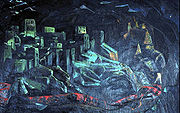
The Doomed City
Encyclopedia

Science fiction
Science fiction is a genre of fiction dealing with imaginary but more or less plausible content such as future settings, futuristic science and technology, space travel, aliens, and paranormal abilities...
novel
Novel
A novel is a book of long narrative in literary prose. The genre has historical roots both in the fields of the medieval and early modern romance and in the tradition of the novella. The latter supplied the present generic term in the late 18th century....
by Arkady and Boris Strugatsky
Arkady and Boris Strugatsky
The brothers Arkady and Boris Strugatsky are Soviet Jewish-Russian science fiction authors who collaborated on their fiction.-Life and work:...
, which is widely considered among the most philosophical of their novels. The name originates from a work by Nicholas Roerich
Nicholas Roerich
Nicholas Roerich, also known as Nikolai Konstantinovich Rerikh , was a Russian mystic, painter, philosopher, scientist, writer, traveler, and public figure. A prolific artist, he created thousands of paintings and about 30 literary works...
which "astonished [the authors] a while ago with its gloomy beauty and the feeling of hopelessness radiating from it." . This novel does not belong to the Noon Universe
Noon Universe
The Noon Universe is a fictional future setting for a number of hard science fiction novels written by Arkady and Boris Strugatsky. The universe is named after Noon: 22nd Century, the chronologically first novel from the series...
, and does not reference, nor is referenced by, any other of their works.
Plot summary
The novel is set in a mysterious world where enigmatic Mentors run a sociological experiment. The mentors gathered volunteers from Earth from various places and times: from Germany of 1940s, the USA of the 60s, Sweden of the 70s, etc. The volunteers do not know the goals or conditions of the experiment. In spite of different native languages the people can effortlessly communicate with each other. Most of the people live in the City that is skirted by a swamp on one side and a desert on the other. Apparently, the experiment runs out of control, the City is shaken by a social unrest and an egalitarian system of job assignments is replaced by a dictatorship.The main character—Andrei Voronin—is an astronomer from Leningrad of 1950s. He struggles to find his identity and his place in the strange city. Eventually, he joins an expedition to explore the desert. The expedition proves difficult in the extreme. The members are exhausted, they turn back or perish. Eventually, only Andrei and Izia (Joseph Katzman) forge ahead. They encounter deserted cities and ruins of Earth cultures that show that the mysterious world is very old and the humans inhabited it for a long time. As Andrei and Izia proceed, they ponder the strange world and the meaning of human existence. They run out of supplies, but they keep going on eager to learn what is beyond the zero point. Andrei dies on the border shooting at his double. He then finds himself back in the Leningrad of 1950s, where his Mentor tells him that he passed the First circle, but "there are many of them ahead".
History of Creation and Publication
The authors got the first idea of the "The Doomed City" in March 1969. At first, the novel was conceived as an autobiography. The authors say that they never worked longer or more diligently on any other of their works than on this novel. The draft of the novel was finished in 1972. After completion the authors shelved the draft as they did not hope to ever see the novel published. The political allusions, the spirit of despondency and its ideological vacuum made the novel unacceptable for the Soviet regime. The attempted publication would have been stopped by the censors. However, the authors hoped that by submitting the draft to the publishing houses the people who read it may make copies and the novel might find its reader through samizdatSamizdat
Samizdat was a key form of dissident activity across the Soviet bloc in which individuals reproduced censored publications by hand and passed the documents from reader to reader...
. The novel was finally published in 1989 after the controls on publishing were eased during Glasnost
Glasnost
Glasnost was the policy of maximal publicity, openness, and transparency in the activities of all government institutions in the Soviet Union, together with freedom of information, introduced by Mikhail Gorbachev in the second half of the 1980s...
and Perestroika
Perestroika
Perestroika was a political movement within the Communist Party of the Soviet Union during 1980s, widely associated with the Soviet leader Mikhail Gorbachev...
.

